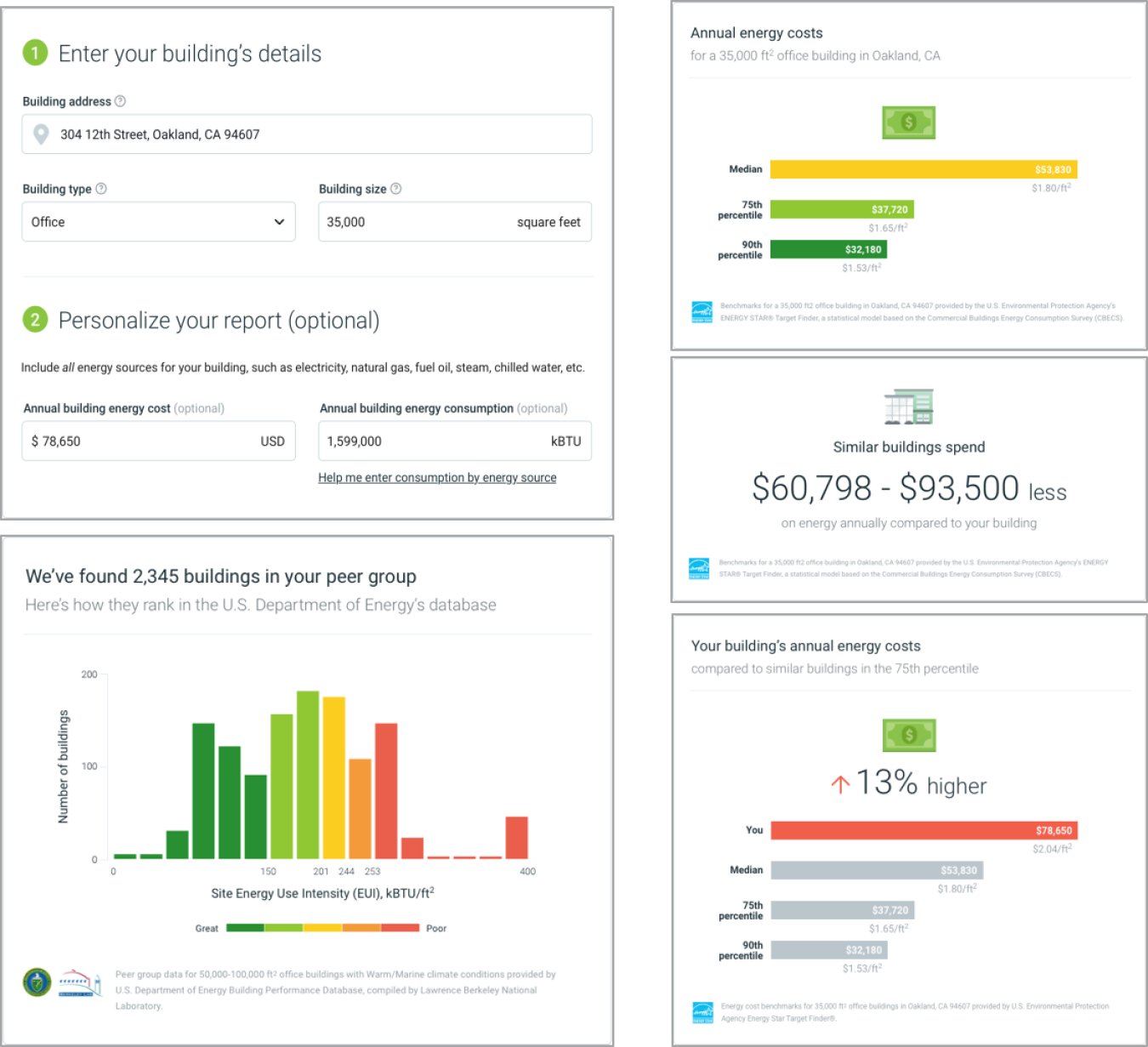Oakland-based Lucid leveraged DOE’s Building Performance Database and Small Business Voucher program to develop a free energy benchmarking service.
March 30, 2017
Lucid’s free BenchmarkMyBuilding service draws data from DOE’s Building Performance Database (BPD) and EPA’s ENERGY STAR Target Finder to present statistically meaningful benchmarks given location, use-type, and floor area descriptors.
Commercial buildings hold significant opportunities for both short-term and long-term energy and cost savings and corresponding opportunities for investment. An increasing number of data sources are available to help identify these opportunities—smart meter, smart thermostat, building automation system (BAS), and sensor data streams provide detailed information about the building while disclosure ordinances provide coarse-grain information about populations of similar buildings. However, turning this data into energy-efficiency projects still presents a challenge for building owners and operators.
One of the companies working to change that is Lucid, an Oakland, California, software startup whose BuildingOS service automates collection, organization, and analysis of building energy data. Started in 2004, Lucid works with more than 700 clients to track energy data in over 11,000 buildings representing more than a billion square feet. These clients use BuildingOS to aggregate and organize their various building energy data streams and to engage their occupants in improving building operations.
Looking to expand its offering to benchmarking and deeper ECM analysis, Lucid turned to DOE’s innovative Small Business Voucher (SBV) program. Rather than competitively awarding money to small businesses, SBV awards the time, effort, and expertise of national lab scientists and engineers. The small business gains access to expertise—and sometimes to specialized lab facilities—it would not be able to afford on a full-time or contract basis. The lab and its scientists get the real-time real-world feedback that comes from commercial deployments. Lucid was paired with Lawrence Berkeley National Lab (LBNL) to help integrate Building Performance Database (BPD) and OpenStudio into BuildingOS.
Along with the Environmental Protection Agency’s (EPA) ENERGY STAR Target Finder, BPD was integrated into a new free benchmarking service, BenchmarkMyBuilding. LBNL helped Lucid leverage the more than 200,000 anonymized commercial building records within BPD—including records corresponding to the most recent Commercial Building Energy Consumption Survey (CBECS)—to create a consistent and statistically meaningful benchmark dataset. Lucid launched BenchmarkMyBuilding on March 15, 2017 as a gateway that allows building owners and property managers to engage with energy data using three simple, easy-to-acquire inputs—building location, building type (office, retail), and building square footage. These three inputs produce a performance distribution from similar buildings, hopefully leading owners of poorly performing buildings—really, owners of all buildings—to BuildingOS for more detailed and more actionable energy use tracking.
“BenchmarkMyBuilding paves the way to integrate operational efficiency with retrofit analyses on a broad scale. By offering the DOE and EPA tools in an approachable user-friendly format, this application has the potential to make a tremendous impact on both business costs and the environment”, says Tianzhen Hong, an LBNL scientist who worked with Lucid on the project.
“BenchmarkMyBuilding will allow us to expand the audience of building owners interested in saving energy and costs,” says Lucid’s Josh Wentz, the architect of BenchmarkMyBuilding. “We believe it will have great impact and we are thrilled.”
LBNL also helped Lucid integrate OpenStudio into its BuildingOS premium service. Specifically, LBNL used OpenStudio to extend its Commercial Building Energy Saver (CBES) database of Energy Conservation Measure (ECM) savings estimates. LBNL extended CBES from 16 climate zones to 861 individual climate locations, added models for large office buildings, and evaluated six additional ECMs, including air-side economizers, high-performance chillers, and variable speed fans in air-handling units. These additions will allow BuildingOS users to investigate capital improvements in addition to operational ones.
“None of this would have been possible without the DOE’s Small Business Voucher program, which brought together Lucid’s focus on design and business with LBNL’s expertise in modeling and building data analysis,” Wentz adds. “It was a great collaboration.”
Dr. Amir Roth
Dr. Amir Roth is the technology manager for BTO’s Building Energy Modeling (BEM) subprogram and has served in that role since 2010. From 2001 to 2010 he was first an assistant and then an associate professor with tenure of Computer and Information Sciences at the University of Pennsylvania in Philadelphia. He graduated magna cum laude with a B.S. in physics from Yale University and holds a Ph.D. in computer science from the University of Wisconsin—Madison where he won a dissertation award in 2001. He is a member of the American Society of Heating, Refrigeration, and Air-Conditioning Engineers (ASHRAE), and the International Building Performance Simulation Association (IBPSA).
Email Amir Roth ►



